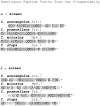Defining a Clade by Morphological, Molecular and Toxinological Criteria: Distinctive Forms related to Conus praecellens A. Adams, 1854
- PMID: 20835370
- PMCID: PMC2936482
Defining a Clade by Morphological, Molecular and Toxinological Criteria: Distinctive Forms related to Conus praecellens A. Adams, 1854
Abstract
We carried out a definition of the species group to which Conus praecellens A. Adams 1854 belongs using a combination of comparative morphological data, molecular phylogeny based on standard genetic markers and toxinological markers. Prior to this work, Conus praecellens was generally postulated to belong to a clade of similarly high-spired, smaller Conusspecies such as Conus pagodus Kiener, 1845, Conus memiae (Habe & Kosuge, 1970) and Conus arcuatus Broderip & Sowerby, 1829. The molecular phylogeny and toxinological data demonstrate that these prior hypotheses are incorrect, and that instead, Conus praecellens is in a branch of Conus that includes Conus stupa (Kuroda, 1956), Conus stupella (Kuroda, 1956), Conus acutangulus Lamark, 1810 and surprisingly, some species that are morphologically strikingly different, Conus mitratus Sowerby, 1870 and Conus cylindraceus Broderip & Sowerby, 1830. A more careful analysis of the morphologically diverse forms assigned to Conus praecellens suggests that from the Philippine material alone, there are at least three additional undescribed species, Conus andremenezi, Conus miniexcelsus and Conus rizali. A reevaluation of protoconch/early teleoconch morphology also strongly suggests that Conus excelsus Sowerby III, 1908 is related to these species. Together, the different data suggest a clade including the 10 species above that we designate, the Turriconus (Shikama and Habe, 1968) (clade; there are additional distinctive forms within the clade that may be separable at the species level. The phylogenetic definition using the multidisciplinary approach described herein provides a framework for comprehensively investigating biodiverse lineages of animals, such as the cone snails.
Figures








References
-
- da Motta AJ. A systematic classification of the gastropod family Conidae at the generic level. La Conchiglia; Rome: 1991.
-
- Huelsenbeck JP, Ronquist F, Nielsen R, Bollback JP. Bayesian inference of phylogeny and its impact on evolutionary biology. Science. 2001;294:2310–4. - PubMed
-
- Larkin MA, Blackshields G, Brown NP, Chenna R, McGettigan PA, McWilliam H, Valentin F, Wallace IM, Wilm A, Lopez R, Thompson JD, Gibson TJ, Higgins DG. Clustal W and Clustal X version 2.0. Bioinformatics. 2007;23:2947–8. - PubMed
-
- Lim CF, Wee VTH. Southeast Asian Conus, a seashells book. Seaconus Private Limited; 1992.
Grants and funding
LinkOut - more resources
Full Text Sources
